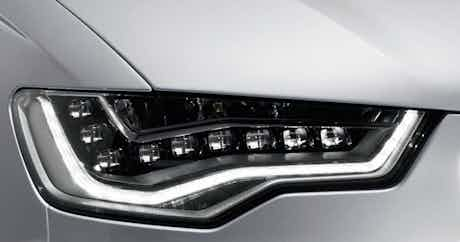What are daytime running lights?
September 14, 2022 by John Tallodi

We cast some light on the topic of DRLs…
As the name suggests, daytime running lights (DRLs) are intended to be used during the day. They typically take the form of a pair of strips of white LEDs in the front bumper, or are integrated into the headlight unit. Modern designs may also see DRLs integrated into a light-bar that runs across the front of a car, while some cars also have rear DRLs, which are red in colour.
This article will look into the law surrounding DRLs as well as how they can contribute to road safety when used correctly.
What are daytime running lights for?
Daytime running lights have been around for decades, but have only been a legal requirement for new cars launched in Europe and the UK since February 2011. This doesn’t mean all cars sold new since 2011 will have DRLs, though, as cars that had been designed and launched before this date didn’t have to have them, nor did they have to be redesigned to feature them.
Daytime running lights are intended to make it easier for other road users to spot a car; they are not intended (or bright enough) to illuminate the road, as this is what your headlights are for. DRLs switch on automatically when a car is started, and switch off when you turn on your headlights or turn off the car.
Front-facing DRLs are required by law, however, rear-facing ones are not. If your car does have DRLs fitted in the rear, they will be a red colour and work in conjunction with the front ones, which are white.
You should still always switch on your regular headlights when there is reduced visibility. If visibility is severely restricted, you may also need to turn on your fog lights (if fitted).

What are the benefits of daytime running lights?
DRLs increase your visibility on the road, and this should lead to lower accident numbers. Numerous studies have found this to be the case.
Studies in the US and Canada estimated that accident rates for cars that had DRLs fitted reduced by 5.7 – 7%. The European Commission released a consultation paper in 2010 which estimated that road fatalities could be reduced by 3 – 5% annually if DRLs were fitted to all cars. The UK government also references research which says that road accidents and fatalities could be reduced by up to 6%.
Are there any disadvantages to daytime running lights?
There have been concerns that drivers may incorrectly assume that because their front DRLs are illuminated, their rear lights will be on as well, as happens with sidelights; yet with rear DRLs not mandatory this can cause a situation where a car is driving with no rear illumination, despite the fact it may be hard to spot due to the conditions.
Research from the RAC in 2018 found that 62% of drivers had encountered cars in dull, overcast conditions driving with no rear lights on, and while automatic headlights (which use sensors to turn on when low light levels are detected) may mitigate this issue, it remains the case that it is not unusual to spot a car with no rear lights on, when they are arguably required.
Do daytime running lights make my car use more fuel?
Not to any meaningful or degree. DRLs use low powered bulbs which in most cases are low-energy LED-type units. LEDs use significantly less power than traditional halogen bulbs and the impact on your fuel consumption is negligible.
Government stats place the increased energy usage at around 0.5% for cars that still use the older non-LED bulbs. LEDs will be a fraction of that figure.
What cars have daytime running lights?
Any new car sold from February 2011-on in Europe and the UK will have daytime running lights fitted as standard.
These will either be standalone items installed in the front of the car or integrated into the headlamp unit. Some cars use their existing position lamps in a lower intensity setting as DRLs.
Rear daytime driving lights are not mandatory so not all manufacturers fit them and you are most likely to find rear DRLs on pricier luxury cars.
If your car was not originally sold with DRLs, there is no legal requirement to have them retro-fitted. It is legal to do so if you wish, however, the aftermarket DRLs need to have the letters ‘RL’ embossed on the lamp to ensure that they have been approved to the correct European legislation.
The DRLs should be installed in such a way that they switch off when the headlamps are turned on, if not they need to be turned off manually at night to avoid dazzling other road users.
Do daytime running lights need replacing?
The LED bulbs found in almost all DRLs these days have a very long lifespan – long enough to last as long as your car. They are maintenance free items, however in the case of an accident or potential malfunction they might need replacing.
The cost of this depends on the make and model of your vehicle. You can change the DRL bulbs on a Volvo XC90 in your own driveway, which means you would only have to pay for the bulb itself.
Cars with DRL lights that are integrated into the existing headlight unit may require a visit to the dealer to repair. This will add a labour cost and might also entail the replacement of some pricier components.
Cars Change? Carwow!
Looking for a new set of wheels? With Carwow you can sell your car quickly and for a fair price – as well as find great offers on your next one. Whether you’re looking to buy a car brand new, are after something used or you want to explore car leasing options, Carwow is your one stop shop for new car deals.















